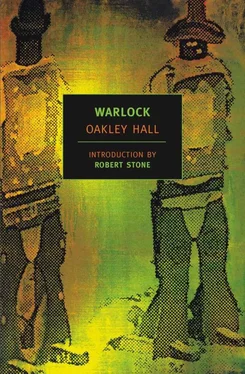Miss Jessie ran down Main Street in the dust, holding her skirts up; she would run swiftly for a time, then decrease her pace to a walk, then run again. “Clay!” she cried.
Gannon began to move forward with the others, as Miss Jessie ran on. The black horse dropped down over the edge of the rim, Blaisedell’s head and shoulders visible for an instant and his ruined face turning back to glance once toward the town; then abruptly he was gone. “ Clay! ” Miss Jessie screamed, with her voice trailing thinly behind her as she ran. The doctor was hurrying after her.
Gannon walked with the others down Main Street toward the rim, where the doctor had caught up with Miss Jessie. The doctor had an arm around her and was leading her back, her face dusty and white with huge vacantly staring eyes, her mouth open and her breast heaving. He saw the wetness at the corners of her mouth as he passed her and the doctor, and her eyes glared for a moment at him, vacant no longer, but filled with tears and hate. He moved on, and heard the doctor whispering to her as he led her back through the groups of men approaching the rim.
III
From the rim the great, dun sweep of the valley was laid out before them. There were wild flowers on the slopes from the recent rain. The long dead spears of ocotillo were covered with a thin mist of leaves, and from their ends red flaming torches waved and bowed in the breeze. Someone extended an arm to point out Blaisedell, where he guided the black horse among the huge tumbled boulders of the malpais. He was hidden from time to time among the boulders and each time he reappeared it was a smaller figure on a smaller horse, trailing tan clouds of dust that lingered in the air behind him. They watched in silence as he rode on down the stage road toward San Pablo and the Dinosaurs, until they could not be sure they saw him still at all, he was so distant. Yet now and then the tiny black figure on the black horse would stand out clearly against the golden, flower-speckled earth, until, at last, a dust devil rose in a gust of wind. Rising high and leaning across his path, it seemed to envelop him, and, when it had passed and blown itself apart, Blaisedell too was finally lost to sight.
AFTERWORD: A Letter from Henry Holmes Goodpasture
1819 Pringle St.
San Francisco, Calif.
May 14, 1924
My Dear Gavin: [1]
It has been a long time now, but I am surprised, as I look into the past in order to answer your letter, how easily it all comes back to me. Perhaps I am able to remember it with such immediacy because you and your brother so often asked me to tell and retell stories of my days in Warlock. That must seem a long time ago to you, who are now in your third year at New Haven, but to me, in my eighty-third upon this planet, it is only yesterday.
I am most pleased that you should recall those old stories, and be interested enough to wish to know, now that you are grown, what happened “After.”
To begin with, Warlock did not continue to prosper and grow as her citizens had once hoped, and when I departed for San Francisco in 1882, her decline was well under way. The Porphyrion and Western Mining Company had by then bought up the rest of the mines, and struggled for a number of years to cope with the increasing amounts of water met with at the lower levels; but it was a hopeless task, and Porphyrion, faced too with the fall of the silver market, was finally forced to the wall. By 1890 only the Redgold Mine was still in operation. The hamlet of Redgold then flourished briefly but, after the mine closed, became in its turn a ghost like Warlock and so many other mining camps.
In answer to your questions, I shall try to be as succinct as it is possible for a garrulous old man to be. Yes, Warlock did become the county seat of Peach County. Its courthouse still stands (or stood the last time I visited Warlock, seventeen years ago), a fine brick structure that was unfortunately gutted by a fire soon after the turn of the century. Curiously, its blackened brick husk seemed to me to have no connection with the adobe husks around it, and even stands near the rim at the southwest corner of the town (where it commands a most striking view of the valley), apart from them. As I say, Warlock was the county seat; but not for long. The county offices were removed to Welltown, I believe in 1891.
Dr. Wagner accompanied Jessie Marlow to Nome, where he died of a heart ailment. Jessie herself operated an establishment there called “The Miners’ Rest” for a number of years, and you will find her mentioned in many accounts of the Gold Rush days. I think she married a man named Bogart, or Bogarde, a prospector and saloonkeeper, and himself a figure of minor importance in Nome.
James Fitzsimmons was one of the I.W.W. leaders imprisoned during the Great War. I have heard nothing of him since.
There was never any doubt in Warlock that John Gannon’s death was cold-blooded murder. Cade had concealed himself in the alley behind the jail, and the shooting took place in Main Street before my store. I saw the body very shortly after the shooting, and poor Gannon had been clearly shot in the back, nor had his revolver been drawn. I was especially struck by the expression on his face, which was remarkably peaceful; he cannot even have known what struck him down.
Cade took flight, but was apprehended in short order by a posse led by Pike Skinner. His trial was a notorious one, and these stories you have heard stem from his defense, which was based upon the contention that Gannon had not only murdered McQuown but had communicated to the Mexican authorities information which resulted in the massacre of the Cowboys in Rattlesnake Canyon. As far as I could see, Cade mustered no evidence whatever to support this, but his accusations were then, and probably still are, widely believed. I know that Will Hart, an honest and intelligent man, professed to believe Cade’s story. I do not.
Although he was tried in Bright’s City, Cade was returned to Warlock for execution, and became the first man legally hanged in Peach County. That was a memorable day.
Pike Skinner was Peach County’s first sheriff. Judge Holloway presided briefly over the bench in Warlock’s new courthouse. Buck Slavin was Warlock’s first mayor. I am sure you will remember hearing stories of his career in the U.S. Senate. He was a colorful man, a brilliant politician, and had a matchless eye for the main chance.
Arnold Mosbie, who served as a deputy under Skinner, became one of the last of the famous peace officers. He was Marshal in Harrisonburg.
I have heard that the notorious “Big-nose Kate” Williams, of Denver fame, or ill fame, was Warlock’s Kate Dollar. I have also heard that Kate Dollar married a wealthy Colorado rancher. One, both, or neither of these stories may be true.
You will notice that I have kept your questions about Blaisedell to the last. No, I cannot say I wish I had been present to hear you and your “know-it-all” friend argue about him. I have heard in my time too many such arguments, and I think you must have held for him as well as I could have done — perhaps better, for I was always chary of making him out a better man than he may have been. What was he? I think in all honesty I must say I do not know, and if I do not know in this late year of Our Lord, then I think that no man can. Certainly your opinionated friend cannot.
Nor do I know what became of him. If anyone ever knew, genuinely, it has been a well-kept secret. Of course there have been many rumors, but never one to which I was able to give any credence. The most common has been that Blaisedell was half-blind when he left Warlock, and soon completely lost his sight. Consequently there were a number of tales, variously embroidered, concerning tall, fair, blind men represented as being Blaisedell.
Читать дальше







